Table of Contents
Quality Service Guarantee Or Painting Free

Get a rental agreement with doorstep delivery

Find the BEST deals and get unbelievable DISCOUNTS directly from builders!

5-Star rated painters, premium paints and services at the BEST PRICES!
Loved what you read? Share it with others!
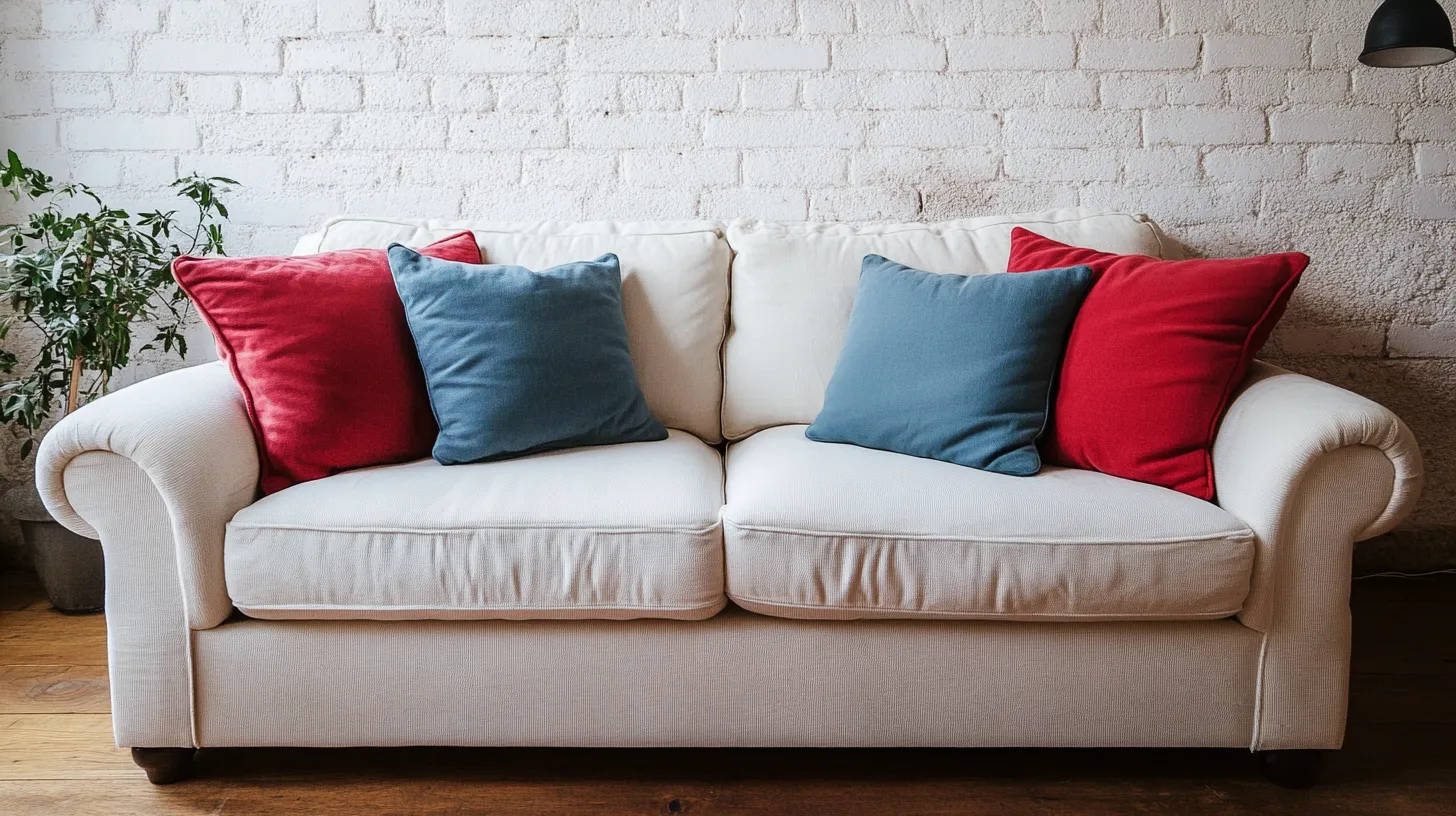

Submit the Form to Unlock the Best Deals Today
Check Your Eligibility Instantly

Experience The NoBrokerHood Difference!
Set up a demo for the entire community

Tenant Super Relax Plan
Enjoy Hassle-Free Renting
 Full RM + FRM support
Full RM + FRM support Instant alerts & premium filters
Instant alerts & premium filters Rent negotiation & relocation help
Rent negotiation & relocation helpSubmit the Form to Unlock the Best Deals Today
How to Clean Couches at Home: Effective Tips for Every Couch Material in 2025
Table of Contents
A couch is more than just furniture. It’s the heart of your living space, where you relax, entertain, and unwind. However, it collects dust, stains, and allergens with constant use, making regular cleaning essential for hygiene and durability. Knowing how to clean couches at home is key to maintaining their appearance. Different materials, from fabric to leather, require specific cleaning methods to prevent damage. Whether using DIY solutions with household ingredients or professional cleaning, the right techniques can keep your couch spotless. This blog will explore the best methods and expert tips to help maintain a clean, hygienic, and long-lasting sofa, ensuring a cosy and beautiful living space.
List of Home-Made Materials Needed for Cleaning Couches for 2025
Keeping your couch clean with homemade cleaning solutions is both cost-effective and eco-friendly. Using common household items, you can remove stains, odours, and dirt without harsh chemicals. Here’s a list of materials you’ll need:
- White vinegar
- Baking soda
- Dish soap
- Rubbing alcohol
- Hydrogen peroxide
- Essential oils (optional)
- Microfiber cloths
- Spray bottle
- Soft-bristled brush
- Vacuum cleaner with upholstery attachment
How to Clean Couches at Home - Easy Steps in 2025

Keeping your couch clean enhances its lifespan and appearance. Dust, stains, and odours build up over time, so regular maintenance with homemade or commercial cleaning solutions can help. Here are the steps to clean a couch at home:
Quality Service Guarantee Or Painting Free

Get a rental agreement with doorstep delivery

Find the BEST deals and get unbelievable DISCOUNTS directly from builders!

5-Star rated painters, premium paints and services at the BEST PRICES!
- Step 1: Examine the care label on your couch for cleaning instructions. Look for symbols: "W" for water-based, "S" for solvent, "WS" for either, or "X" for vacuum only.
- Step 2: Vacuum your couch with an upholstery attachment, concentrating on loose dirt, crumbs, and pet hair from the surface, cushions, and crevices. Focus on seams, where dirt accumulates. Regular vacuuming prevents embedded dirt in the fabric.
- Step 3: Use a fabric cleaner for stains or a homemade mix of water and mild detergent. Test on a hidden area first. Blot the stain gently with a clean cloth, working from outside in. Avoid rubbing to prevent spreading and damaging the fabric.
- Step 4: Wash removable couch covers per the label. Most can be machine-washed on a gentle cycle with cold water and mild detergent. Hand wash delicate fabrics. After washing, air dry or tumble dry on low heat, avoiding high heat to prevent shrinking.
- Step 5: Sprinkle baking soda evenly over the couch to neutralize odors. It effectively absorbs smells without residue. Let it sit for 15-20 minutes before vacuuming thoroughly with the upholstery attachment.
- Step 6: Use a steam cleaner on suitable couch fabric for a deeper clean. Check the care label for safety and follow instructions to avoid oversaturation. This method removes dirt, dust mites, and allergens, keeping your couch fresh.
- Step 7: Fluff cushions after cleaning to restore shape and comfort. Regularly rotate them to ensure even wear and prevent sagging. Fluffing maintains appearance and enhances comfort and longevity.
How to Clean Fabric Couches at Home?
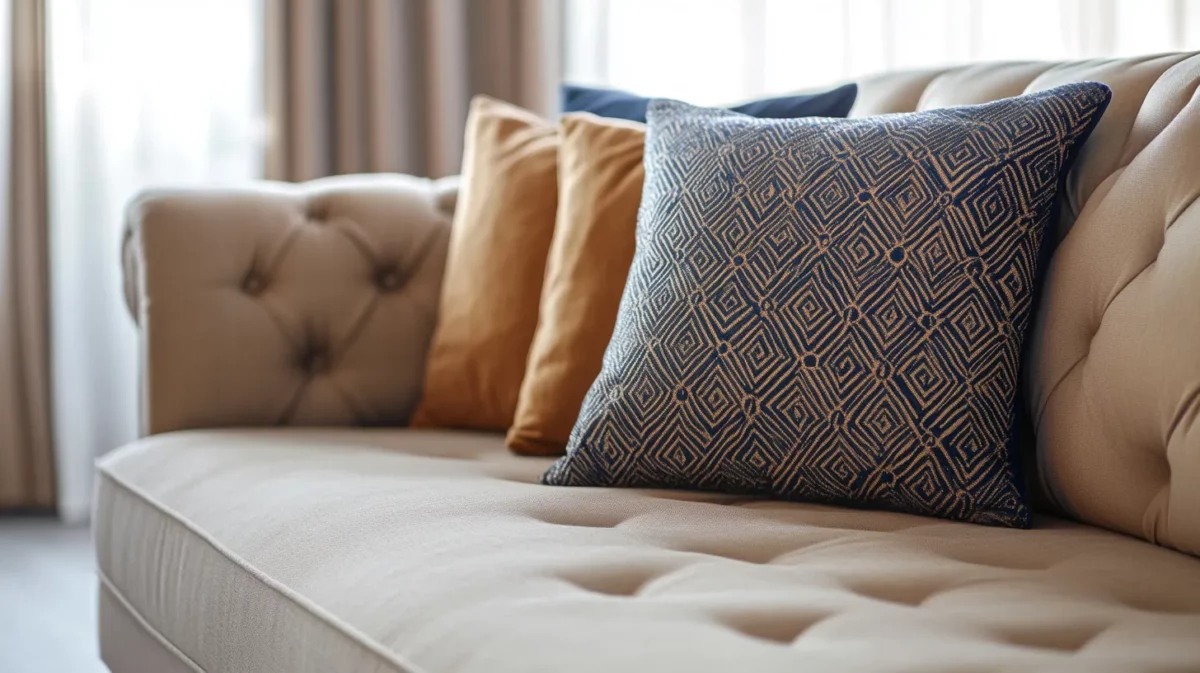
Fabric couches collect dust, spills, and odours quickly. You should always check the manufacturer’s label before cleaning. Let’s explore the steps to clean fabric couches at home:
- Step 1: Remove loose cushions and vacuum the couch with a brush attachment, focusing on the seats, backrests, armrests, and crevices to eliminate dirt and dust.
- Step 2: Ensure the cleaner won't harm your couch fabric. Test a small, inconspicuous area like the back or bottom by applying a small amount. Wait for it to dry, then check for discolouration, fading, or damage.
- Step 3: Mix mild dish soap with water to eliminate stains. Gently dab the spot with a clean cloth soaked in the solution, avoiding rubbing to prevent further discolouration.
- Step 4: Mix mild soap with warm water to create a cleaning solution. Gently clean the couch's surface with a soft cloth or sponge, ensuring the cloth is not soaked.
- Step 5: After cleaning, dip a clean cloth in water, wring it out, and wipe the couch to remove soap residue.
- Step 6: Blot the couch with a dry towel to absorb moisture, then let it air dry completely.
- Step 7: Once dry, use a soft brush to brush the fabric gently. This restores texture and gives a fresh, well-maintained appearance, fluffing any flattened areas to make your couch look new.
How to Clean Leather Couch at Home?
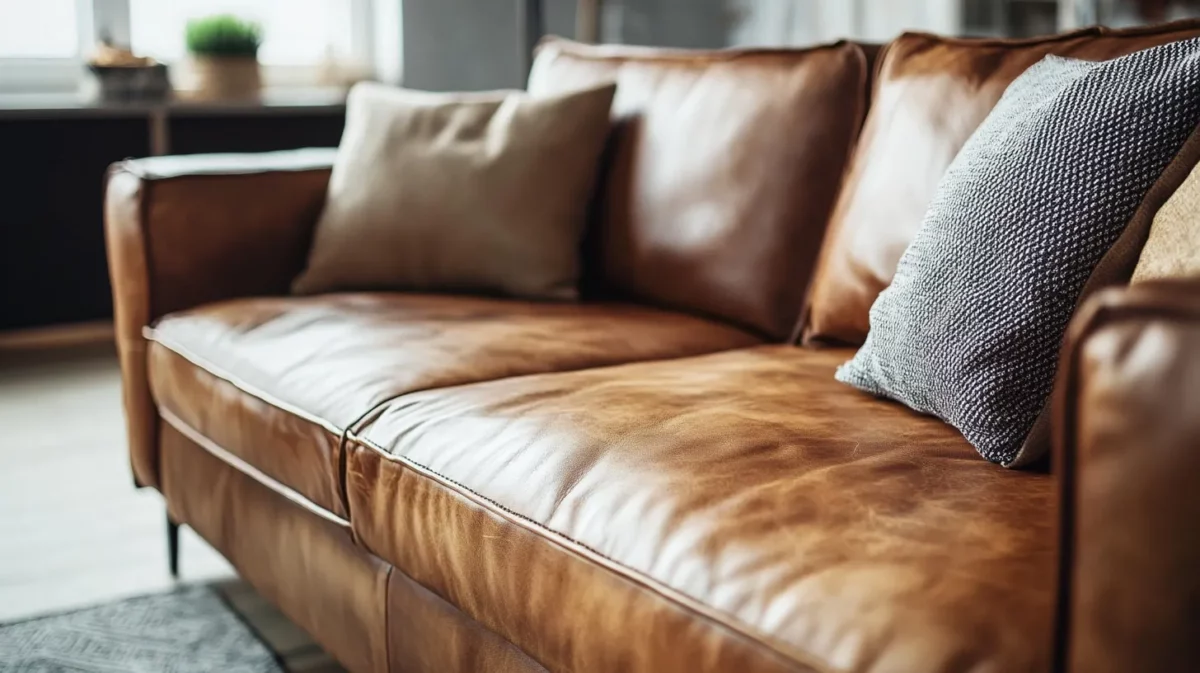
Leather couches are stylish but require special care to prevent drying, cracking, or discolouration. Using a mild solution or natural cleaning agents keeps them clean and conditioned without damaging the material. Here are some simple steps to clean your leather couch at home:
- Step 1: Vacuum the couch to remove crumbs and debris.
- Step 2: Instead of spraying the cleaner directly onto the couch, apply it to a cloth first.
- Step 3: Gently wipe the couch with the cloth from top to bottom, focusing on edges, seams, and crevices.
- Step 4: After cleaning the couch, wipe off excess cleaner before applying leather conditioner.
- Step 5: Let the conditioner absorb for an hour to help the leather fully soak in, preventing residue on clothing. Once dry, your couch will look refreshed and new!
How to Clean Upholstery Couch at Home?
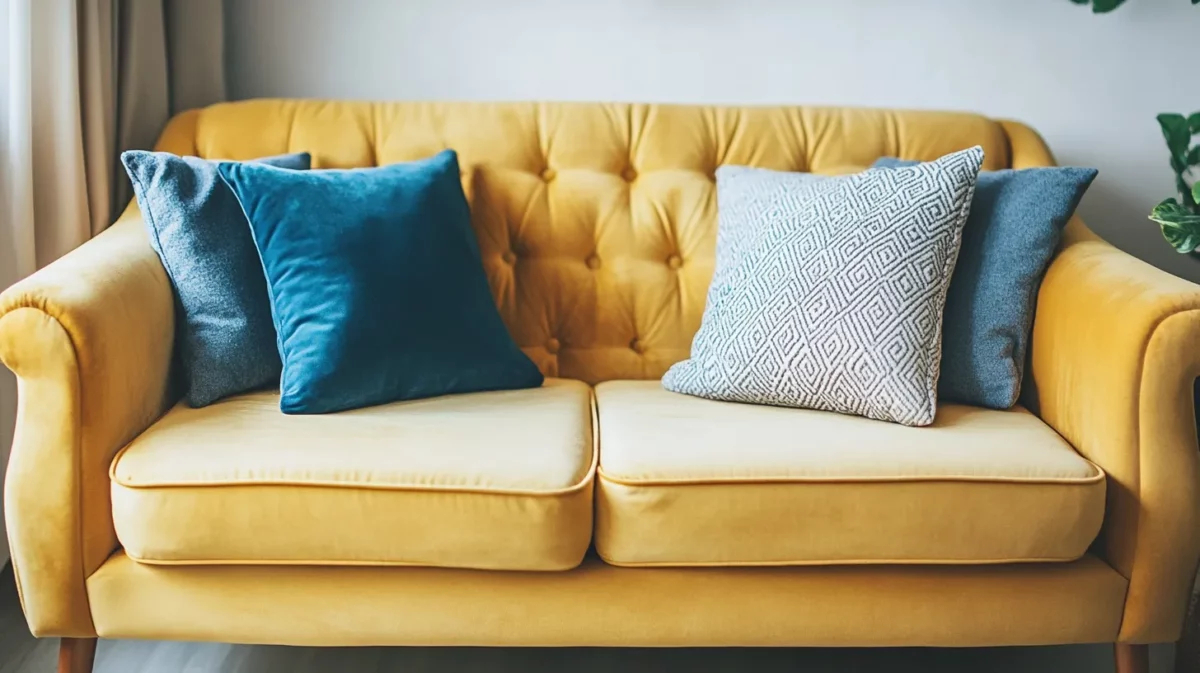
Upholstered couches require routine deep cleaning to remove dust, stains, and odours. You can make use of baking soda as it is a great natural deodoriser, while mild detergent helps lift stains effectively. Let’s explore the simple steps for cleaning upholstery on your couch at home:
- Step 1: Begin by vacuuming the couch thoroughly with the upholstery attachment, focusing on seams, under cushions, and crevices where dirt accumulates.
- Step 2: Before applying any cleaning solution, locate the care tag on your couch. This tag usually contains a cleaning code:
- W: Water-based cleaner
- S: Solvent-based cleaner
- WS: Either water-based or solvent-based cleaner
- X: Vacuum only. Knowing the code helps you choose the correct cleaner and avoid damaging the fabric.
- Step 3: Even if you know the cleaning code, do a spot test. Apply a small amount of cleaner to a hidden area of the couch (like the back or underside). Wait a few minutes and check for discoloration or damage.
- Step 4:
- Water-Based Cleaner: Mix mild detergent with warm water. Dip a white cloth in the solution and blot the stains. Avoid over-wetting the fabric.
- Solvent-Based Cleaner: Apply a small amount of cleaner to a clean, white cloth. Gently blot stained areas. Use in a well-ventilated area and follow instructions.
- Step 5: Blotting lifts stains without spreading them or damaging fibres. Use a clean, white cloth to gently blot the stained areas, changing it frequently to avoid reapplying dirt onto the fabric.
- Step 6: For water-based cleaners, dampen a clean, white cloth and blot the treated areas to remove detergent residue that could attract dirt.
- Step 7: Air dry the couch completely. Use a fan to speed drying, but avoid direct heat sources like hair dryers or space heaters, which can damage the fabric. Ensure good ventilation in the room.
- Step 8: Once the couch is completely dry, fluff and reposition the cushions. This helps maintain their shape and keeps the couch looking fresh and inviting.
How to Clean a Suede Couch at Home?
The suede couch is delicate and can easily get stained or damaged with water. Instead of using liquid cleaners, opt for dry cleaning methods or gentle spot treatments with vinegar or rubbing alcohol for cleaning. Here, we shall discuss cleaning a suede couch at home:
- Step 1: Start with a vacuum cleaner and a soft brush attachment. Gently vacuum the suede couch to remove loose dirt, dust, and debris. Focus on crevices and folds where dust collects.
- Step 2: After vacuuming, use a suede brush to gently lift the nap of the fabric. Brush in one direction to protect the suede and restore its texture, making it look more vibrant.
- Step 3: For minor stains, use a clean, dry cloth to blot. Avoid rubbing, which can spread the stain. If it persists, dampen the cloth with lukewarm water and gently dab the spot. Always test on an inconspicuous area first to prevent discoloration.
- Step 4: For stubborn stains, use a suede or clean pencil eraser. Gently rub it in a circular motion over the stain to lift it without water or harsh chemicals. After removing the stain, brush the area to lift the nap.
- Step 5: If a spill occurs, act quickly. Use a dry cloth to blot and absorb as much liquid as possible. Avoid rubbing, as it can push liquid deeper into the fabric. If needed, apply suede cleaner, following product instructions with a soft cloth and gentle blotting.
- Step 6: Sprinkle baking soda on the couch to eliminate odours. Let it sit for a few hours or overnight to absorb smells, then vacuum it thoroughly. This keeps your suede couch smelling fresh.
- Step 7: After cleaning, use the suede brush to refresh the fabric nap. Brush in one direction for a consistent appearance, making the suede look plush and well-maintained.
- Step 8: Maintain your suede couch by brushing and vacuuming weekly to avoid dirt buildup. Apply a suede protector spray to repel stains and water, following the product instructions for best results.
How to Clean Stains From Couch?

Couches are prone to stains from everyday spills, food, ink, and even mould, making proper cleaning essential. Whether you have a fabric, leather, or upholstered couch, using homemade or commercial cleaning solutions can help remove tough stains without damaging the material. Below are specific methods to tackle different types of stains effectively.
How to Remove Stains From Fabric?
Fabric couches absorb spills quickly, so immediate action is necessary to prevent permanent staining. With basic cleaning agents, you can easily remove stains from coffee, juice, or food spills. Here are the necessary items and steps for cleaning stains from the couch fabric:
Required Items
- White vinegar
- Dish soap
- Warm water
- Microfiber cloth
- Baking soda (for stubborn stains)
Steps for Cleaning
- Step 1: For coffee, juice, or food spills, blot the stain immediately using a dry microfiber cloth or paper towel to soak up excess liquid. Avoid rubbing, as it can spread the stain further into the fabric.
- Step 2: Mix one tablespoon of dish soap, one tablespoon of white vinegar, and two cups of warm water in a bowl. Dip a clean microfiber cloth into the solution and gently dab the stained area.
- Step 3: For tougher stains, sprinkle baking soda over the affected spot and let it sit for 15 minutes to absorb any remaining residue. Vacuum the area to remove the baking soda.
- Step 4: Allow the couch to air dry naturally, and repeat if necessary.
How to Remove Pen Marks From Couch?

Ink stains from pens can be tricky to remove, but rubbing alcohol or hairspray can break down the ink without causing damage. It’s important to test a small hidden area first to ensure the solution won’t discolour your couch. Here’s a simple guide to help you easily remove those pesky pen marks from your surface couch:
Required Items
- Rubbing alcohol or hairspray (with alcohol content)
- Cotton balls or microfiber cloth
- Mild dish soap (optional)
- Warm water
Steps
- Step 1: Soak a cotton ball or a microfiber cloth with a small amount of rubbing alcohol or alcohol-based hairspray.
- Step 2: Gently blot the ink stain—avoid rubbing, as it can spread the ink further into the fabric.
- Step 3: If the stain is persistent, mix a few drops of dish soap with warm water and lightly wipe the area to remove any remaining ink residue.
- Step 4: Use a clean, damp cloth to wipe off any excess cleaner and allow the couch to air dry.
How to Remove Mould From Leather Couch?
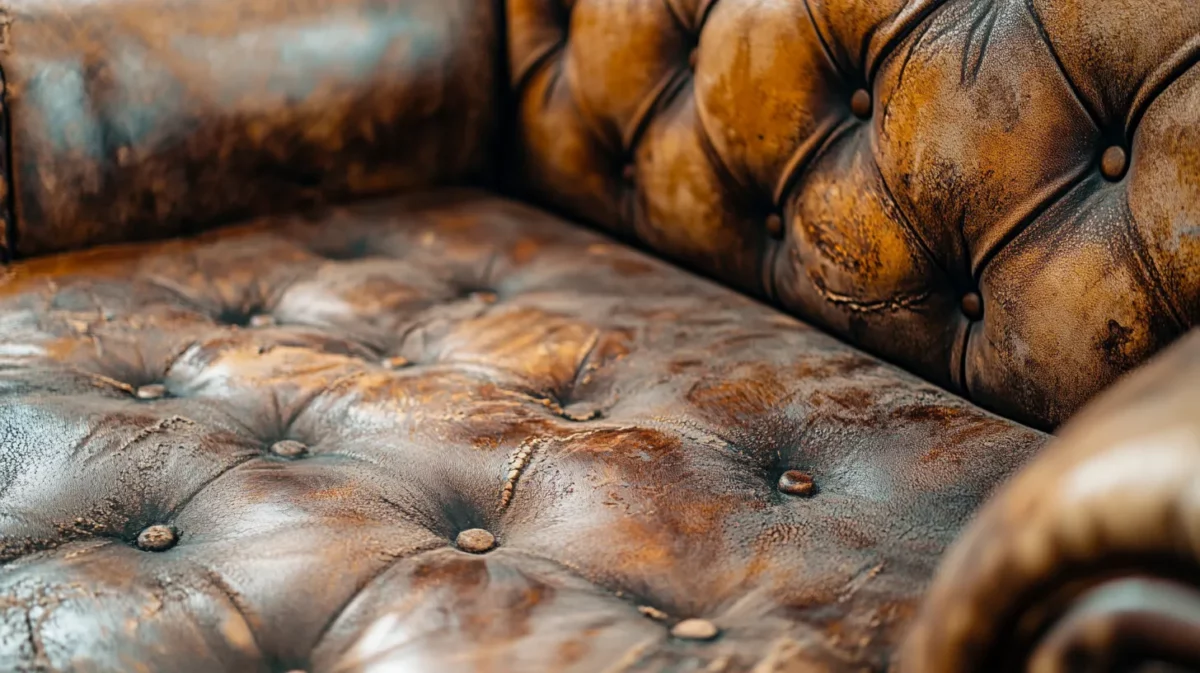
Mould on leather couches not only leaves unsightly stains but can also produce a musty odour. Since leather is sensitive to moisture, using a vinegar solution for cleaning helps kill mould without causing damage. Regular conditioning keeps the leather soft and prevents cracking. The following materials and procedures are required for the effective removal of mould from a leather couch:
Required Items
- White vinegar
- Water
- Microfiber cloth
- Leather conditioner (optional)
Steps for Cleaning
- Step 1: Mix vinegar and water in a spray bottle. Avoid direct contact with leather to prevent over-saturation.
- Step 2: Dampen a microfiber cloth with the solution and gently wipe affected areas to kill spores and remove stains.
- Step 3: Use a dry microfiber cloth to remove excess moisture and let the couch air dry.
- Step 4: Apply a leather conditioner after drying to maintain texture and protect against damage.
How to Remove Smell From Couch?
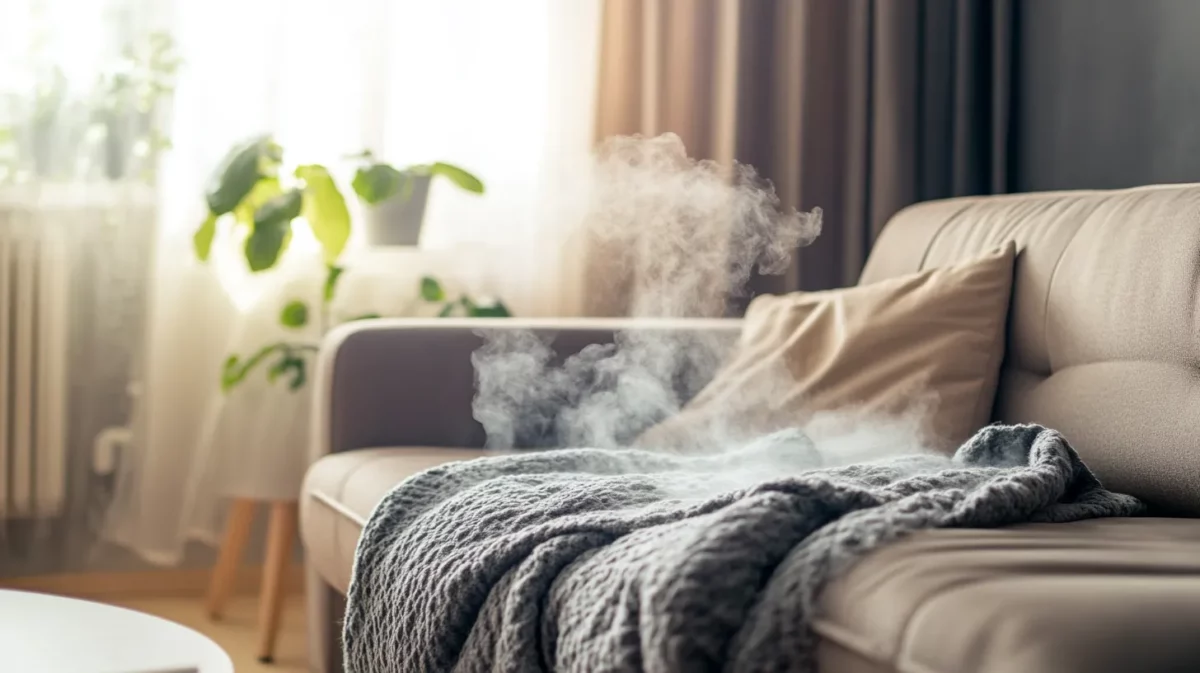
Over time, couches can absorb unpleasant odours from food spills, pets, smoke, and daily use. These lingering smells can make your living space feel less fresh. Here is the step-by-step process for cleaning the couch at home, which aids in the removal of smell:
- Step 1: Vacuum the Couch: Use a vacuum with an upholstery attachment to remove dust, pet hair, and debris from the fabric. Focus on crevices, under cushions, and armrests to prevent dirt buildup and worsen odours time.
- Step 2: Apply Baking Soda or Odour-Neutralising Powder: Sprinkle baking soda on the couch to absorb odours. Let it sit for 30 minutes or overnight for stronger smells. Alternatively, use a commercial upholstery deodoriser for enhanced effect effectiveness.
- Step 3: Vacuum Again to Remove Residue: Vacuum thoroughly after using baking soda or an odour neutraliser to remove residue, especially from dark fabrics. If using a commercial product, check for a second application for stubborn odours.
- Step 4: Use a Vinegar Solution or Fabric Deodoriser: Mix vinegar and water in a spray bottle to mist the couch, eliminating odours without soaking. Alternatively, use fabric deodoriser or antibacterial cleaner. Allow the couch to air dry completely.
- Step 5: Add a Fresh Scent With Essential Oils: To fragrance your couch, add a few drops of essential oil (like lavender, lemon, or tea tree) to a clean microfiber cloth and wipe it down. Alternatively, mix essential oils with vinegar before cleaning and spraying.
- Step 6: Allow Proper Air Circulation: Open windows or use a fan to speed drying and eliminate odours. Fresh air prevents musty smells and keeps your couch smelling clean longer.
How to Remove Cat Urine Smell From Couch?
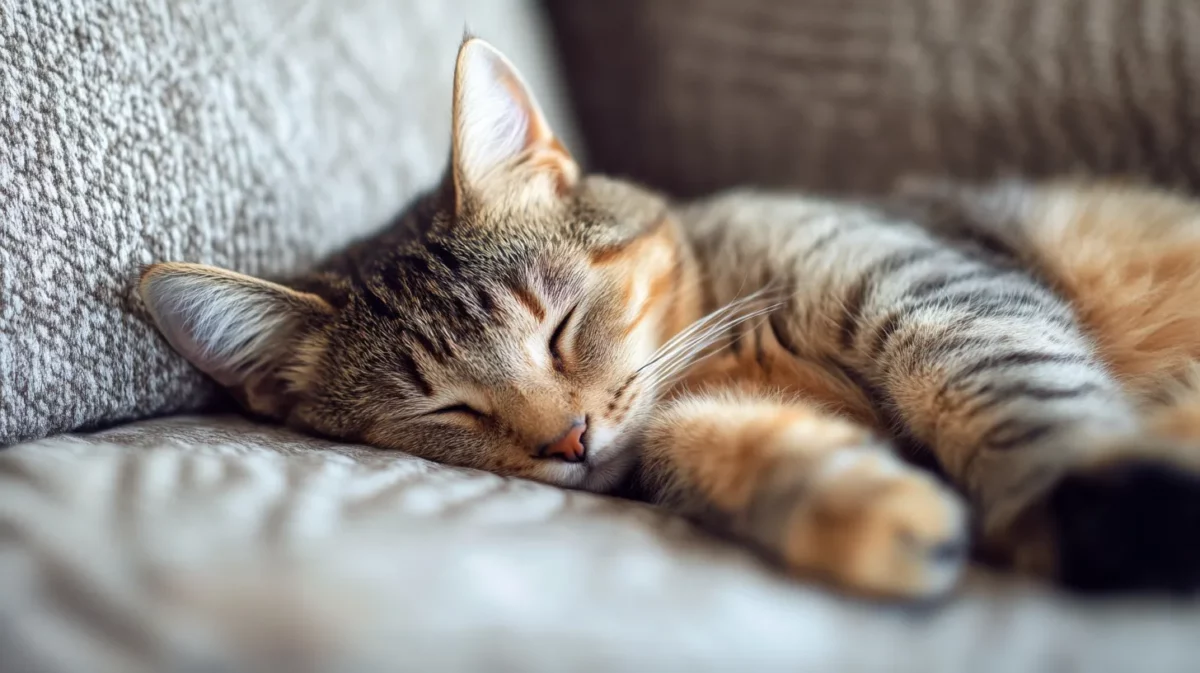
Cat urine has a strong, persistent odour that can be difficult to eliminate if not treated quickly. The key is to neutralise the smell rather than just masking it. Using natural deodorisers, enzymatic cleaners can effectively remove the odour and prevent repeat accidents. Use these steps to remove the smell of cat urine from the couch:
- Step 1: Blot the Urine Immediately: For fresh urine, use paper towels or a clean cloth to blot the liquid. Press firmly to absorb, avoiding rubbing to prevent the spreading fabric.
- Step 2: Use a Vinegar Solution: Mix equal parts vinegar and water in a spray bottle. Spray the area, avoiding oversaturation. Vinegar neutralises the uric acid in cat urine, which causes the odour. Let sit for 10–15 minutes.
- Step 3: Absorb Moisture with Baking Soda: After the drying up of the vinegar solution, sprinkle a generous amount of baking soda for cleaning over the dirty area. Baking soda absorbs odours. Let it sit for 30 minutes or overnight for stronger smells.
- Step 4: Use an Enzymatic Cleaner: Enzymatic cleaners eliminate pet urine odours. Spray the area and follow instructions; let it air dry completely for best results removal.
- Step 5: Vacuum and Refresh: After the area dries, vacuum up the baking soda. If desired, mist the couch with water and a few drops of essential oil for a fresh scent.
- Step 6: Prevent Future Accidents: Clean the area thoroughly and use a pet deterrent spray or aluminium foil on the couch when not in use to discourage urination. Regular cleaning prevents repeat incidents.
How to Keep Your Couch Clean for Longer?
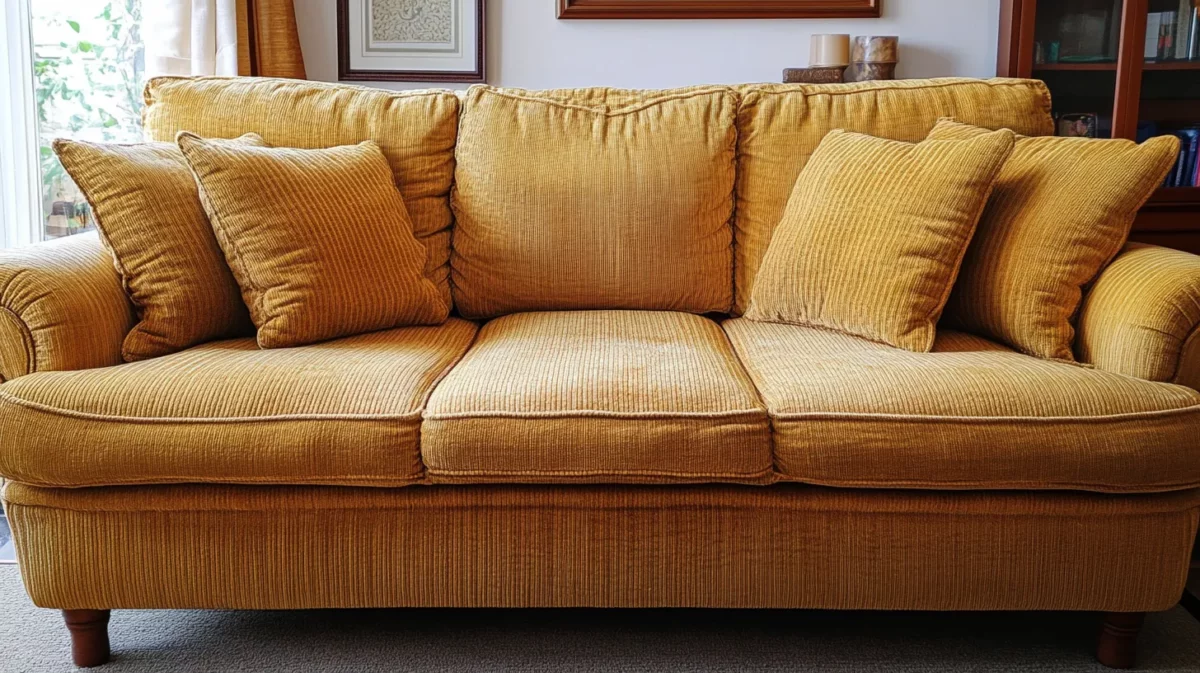
Regular maintenance helps keep your couch looking fresh and extends its lifespan. Dust, spills, and pet hair can accumulate over time, so simple cleaning habits will prevent deep stains and odours. Follow these easy tips to maintain a clean and fresh couch for longer:
- Vacuum Weekly: Use an upholstery attachment to remove dust, crumbs, and pet hair from fabric. Regular vacuuming prevents buildup and keeps allergens away, ensuring a cleaner, healthier living space.
- Use Slipcovers or Throws: Protect your couch with washable slipcovers or throws to reduce spills, dirt, and pet hair. They are easy to clean and extend their lifespan.
- Clean Spills Immediately: Blot spills immediately with a clean cloth to prevent stains. Avoid scrubbing, which can spread the stain and damage upholstery fibres.
- Rotate cushions: regularly to ensure even wear and prevent sagging. This step maintains the couch’s shape and comfort, helping it look new and longer.
- Deodorize Monthly: Sprinkle baking soda on the couch monthly and let it sit for 30 minutes before vacuuming. This absorbs odours and freshens the fabric.
How NoBroker Can Help?
A clean couch enhances the comfort and aesthetics of our living space while ensuring a hygienic environment. Regular maintenance, from vacuuming to deep cleaning, helps prolong the life of our upholstery and keeps it free from dirt, stains, and allergens.
For a deep and professional couch cleaning experience, you can reach out to NoBroker Cleaning Services. Our expert cleaners use safe and effective techniques to remove dirt, stains, and allergens, leaving your upholstery spotless and refreshed. Book a service today and enjoy a cleaner, healthier home!
Frequently Asked Questions
Ans: Clean your couch every 3–6 months to maintain appearance and hygiene. Vacuum regularly to remove dust, and deep clean to eliminate dirt, bacteria, and odours. Homes with pets or children may need more frequent cleaning.
Ans: Use mild detergents or fabric cleaners on your couch. Avoid harsh chemicals like bleach or ammonia, damaging fabric or leather. Always check the manufacturer's label and do a patch test before application.
Ans: You can use a steam cleaner on most fabric couches, but check the manufacturer's instructions. Steam cleaning effectively removes dirt, bacteria, and allergens. Ensure your couch dries properly to prevent mould or mildew growth.
Ans: If your couch still smells after cleaning, sprinkle baking soda on it, let it sit for a few hours, and then vacuum it off. You can also wipe the surface with a vinegar and water mixture or place activated charcoal nearby to absorb lingering odours.
Ans: To clean couches at home, use mild detergent, warm water, and a soft cloth or sponge. Always test a small area first for colourfastness. For deep stains, use a specialized upholstery cleaner and avoid soaking the fabric to prevent damage.
Ans: Sprinkle baking soda on your couch, let it sit for a few hours, and then vacuum to eliminate odours. Alternatively, use fabric-safe air fresheners and essential oil sprays, or place dryer sheets under cushions for lasting freshness.
Ans: To clean a white couch, use mild detergent and water, gently scrubbing stains with a soft cloth. For tougher stains, use a fabric cleaner or a baking soda mixture. Avoid dark clothes to prevent colour transfer.
Ans: To clean a leather couch, mix equal parts vinegar and water, dampen a cloth with it, and wipe the leather. Use a dry cloth to remove excess moisture. A bit of coconut or olive oil can help maintain softness and shine.
Recommended Reading
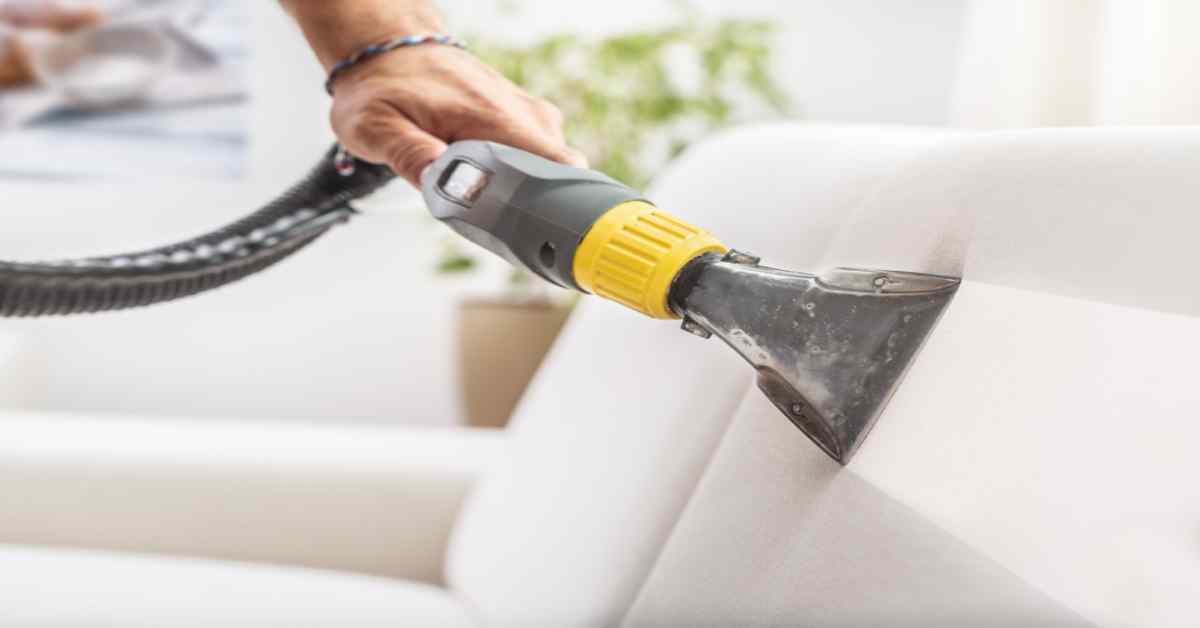
Sofa Cleaning Vacuum Cleaner: Types, Uses & Expert Recommendations in 2025
January 31, 2025
13773+ views

How to Clean Sofa at Home: Easy Steps to Remove Strains, Dust and Bacteria
January 31, 2025
12986+ views
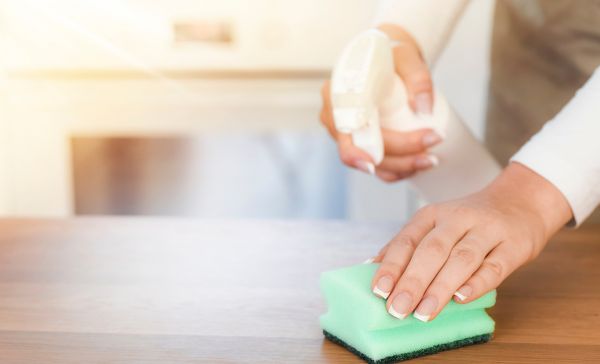
How to Clean Wood Furniture: Easy Steps for Long-Lasting Shine with Natural Cleaners
January 31, 2025
7578+ views
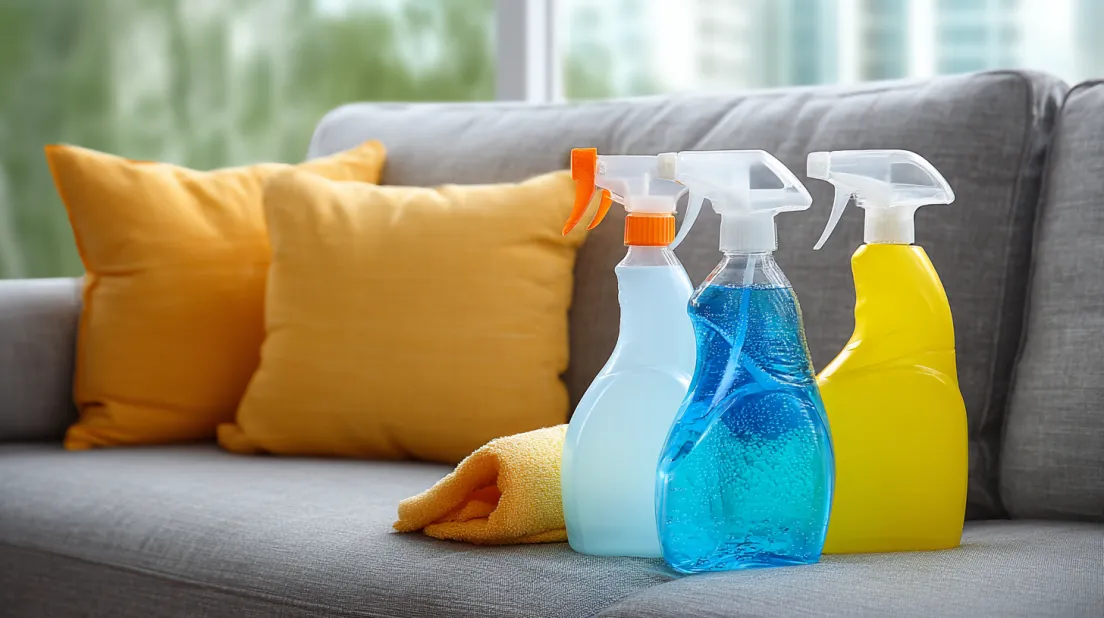
10 Best Sofa Cleaning Liquids in India : Latest Price, Types and Application Methods
July 2, 2025
4479+ views

5 Simple Ways to Care for Your Furniture
August 31, 2023
2942+ views
Loved what you read? Share it with others!
NoBroker Easy Cleaning Tips Testimonials
Awesome 👍
Nice
Nice
Nice👍
Good
Amazing
Best home cleaning services provider
“Great experience! The NoBroker home cleaning team was punctual, professional, and made my house look fresh and spotless. Worth the money!”
Perfect
Best
Good
Woww amazing work
Amazing
No broker home cleaning was smooth and hair with friendly staff and excellent cleaning quality
Excellent work and best service 😊
"NoBroker home cleaning did a fantastic job—reliable service and my home feels fresh and new."
Staff was polite and cleaning quality was impressive. Recommended.”
"NoBroker home cleaning delivered great value for money with punctual staff and impressive results."
Staff was polite and cleaning quality was impressive. Recommended.”
I m hired Nobroker home cleaning and they work perfectly. Definitely try this
Timely, clean, and hassle-free service. Happy with the work!”
NoBroker home cleaning services one off the best service.
Good work
Good services + good team
Excellent work 💯👏
Nice work 😍
Ossum work 🥰
Nice work 💞
Very good experience
Excellent
Suparr
Good
Awesome
Good service providers. I guess they are best in my view.
My goods were delivered on time, as promised, with careful handling.
NoBroker Movers made my relocation stress-free and seamless.
The service was reliable, with attention to detail and a commitment to quality.
My goods were delivered on time, as promised, with careful handling.
NoBroker Movers provided a smooth and stress-free relocation experience.
Most Viewed Articles

List of the Best Home Cleaning Apps: Book Home Cleaning Services for Daily and Deep Cleaning
January 31, 2025
21302+ views
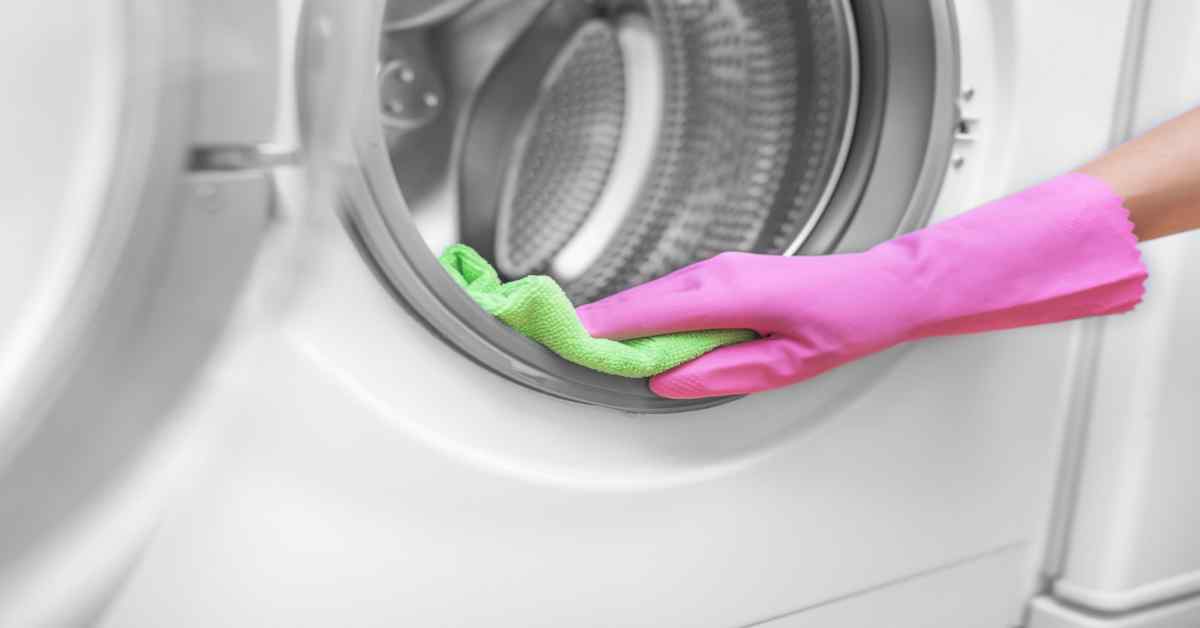
Deep Clean Your Washing Machine: Step-by-Step Guide & Tips
January 31, 2025
18485+ views

Diwali Cleaning Tips and Guide: Make Your Home Shine for the Festival in 2025
January 31, 2025
17824+ views
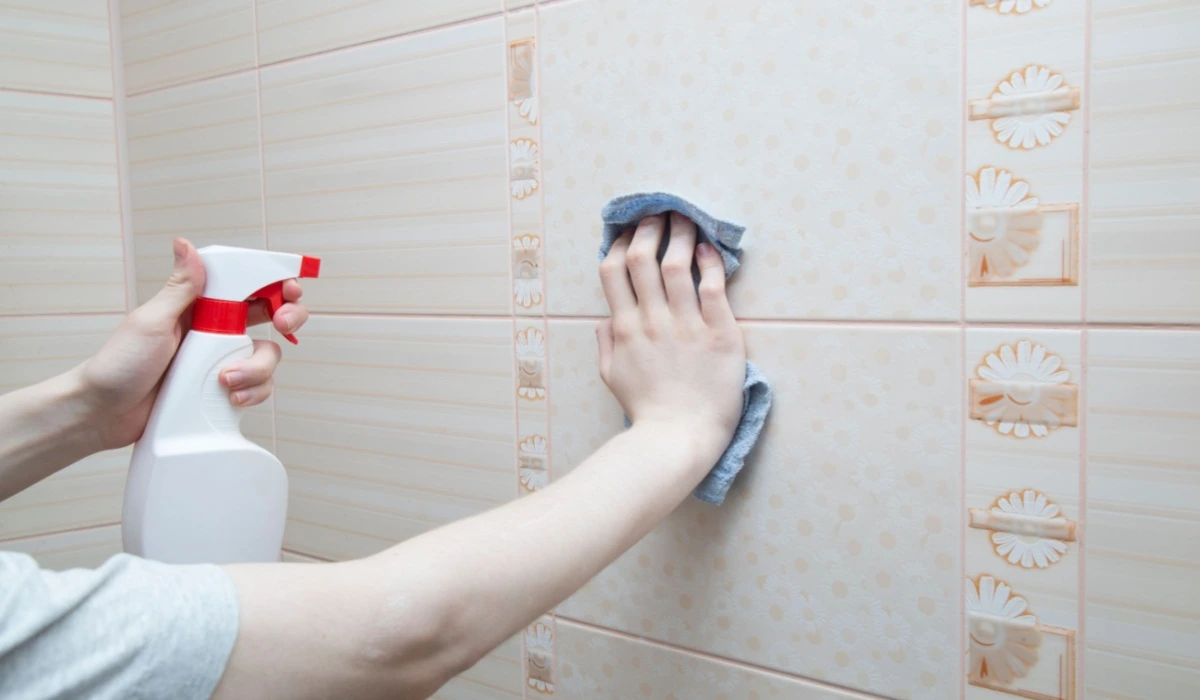
How to Clean Bathroom Tiles: Easy and Effective Methods to Remove Stains and Grout
January 15, 2025
15861+ views

Top 10 Tile Cleaner Liquids with Prices in India for 2025
February 23, 2025
14134+ views
Recent blogs in
How to Clean Wall Wallpaper at Home Without Damage: Easy DIY Cleaning Tips
November 24, 2025 by Priyanka Saha
Most 10 Common Cleaning Mistakes and How to Fix Them for a Truly Spotless Home
November 21, 2025 by Ananth
Zero-Waste Cleaning Routine for Indian Homes: Simple, Natural & Sustainable Home Care
November 21, 2025 by Vivek Mishra







Join the conversation!